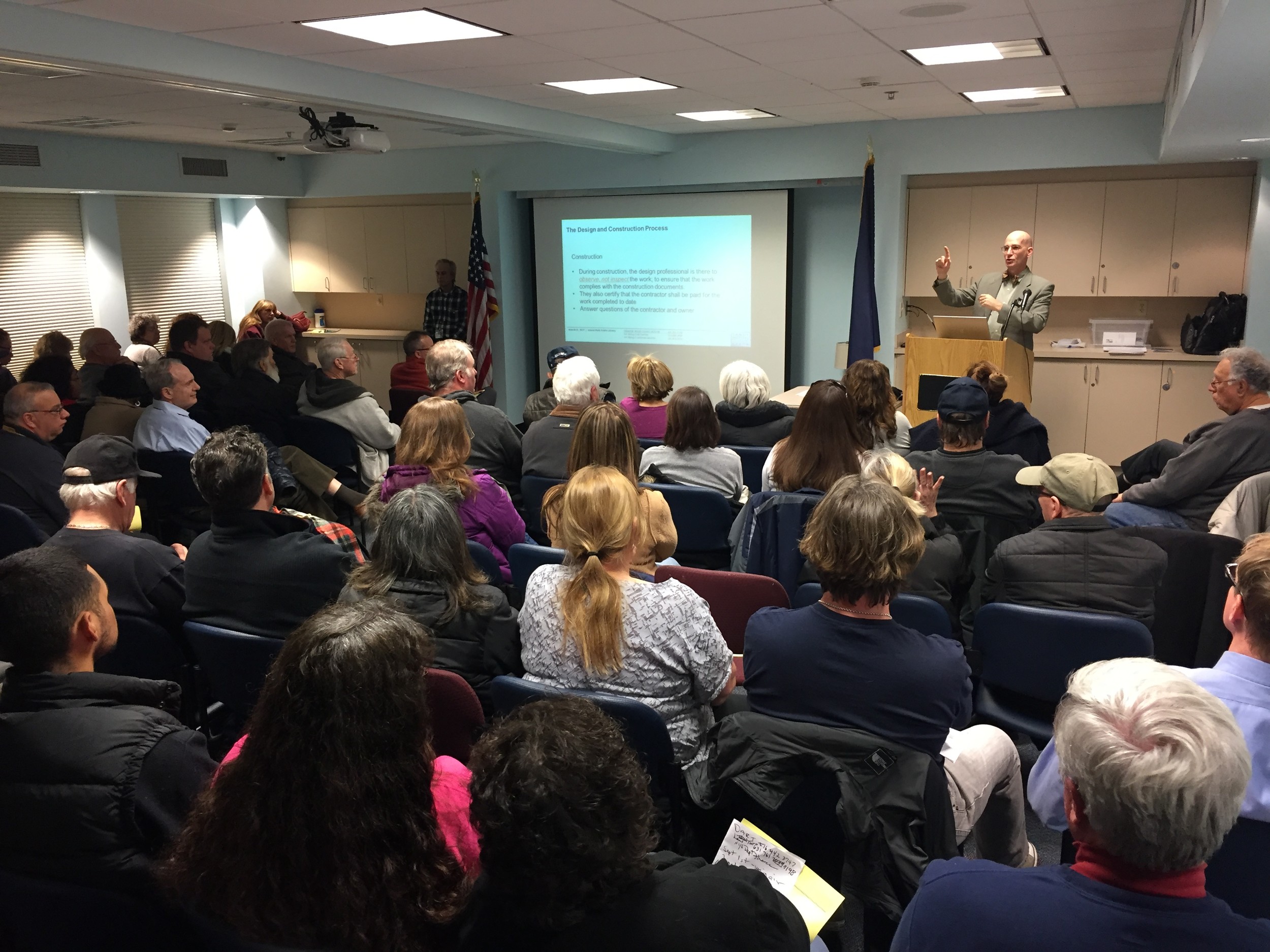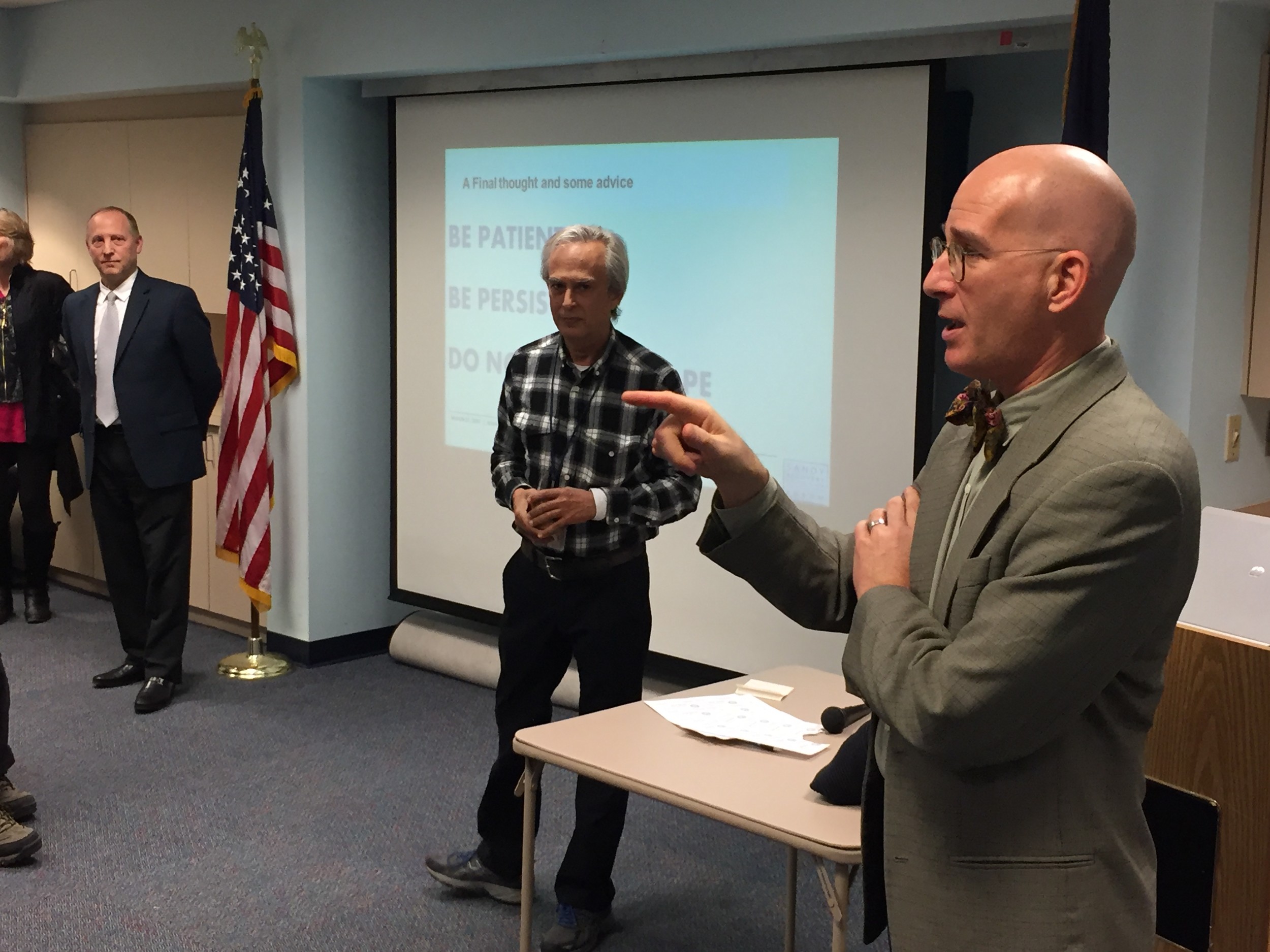Thursday, April 25, 2024
 47.0°,
Mostly Cloudy
47.0°,
Mostly Cloudy
Homeowners seek storm recovery guidance
More than 100 people turn out at Island Park Library for forum
For many, Hurricane Sandy is a distant memory. But homeowners along the South Shore are still living through the aftermath of the 2012 storm which has extended its impact into 2017.
“October 29 really changed all of our lives back in 2012,” said Michael Raab, Nassau County’s storm recovery liaison, who led a meeting at the Island Park Library on March 22. “Here we are, four and a half years later, and look how many people are in this room still looking for guidance, help and reassurance that they’re on the right track.”
More than 100 residents of Island Park and surrounding communities packed the library’s upstairs room for the forum, which offered updates on the workings of the Governor’s Office of Storm Recovery — under the umbrella of New York Rising — and other Sandy recovery options.
“This is an unusually well-attended event,” Library Director Jessica Koenig laughed. “You couldn’t even call it standing-room-only. There wasn’t any standing room.”
Raab, whose Freeport home took on six feet of water during Sandy, said he was diagnosed with post-traumatic stress disorder during the recovery. Still, he continues to help hundreds of families navigate what he called the “administrative stupidity” of New York Rising, adding, though, that the program is more “understandable and negotiable” today than it had been.
“We’re no longer thinking as victims,” Raab said. “We are now Hurricane Sandy survivors. We do have to move on.”
The event gave attendees information about the Disaster Action Response Team — which provides free services from mental health professionals — as well as Touro Law School, which has helped many Sandy victims with storm-related legal matters.
Raab, along with Brian Baer of the nonprofit Elevated Studio, and Brian Bergman, president of Long Beach-based insurance firm Meyerson-Roth Co., also detailed some of New York Rising’s programs and deadlines, and answered questions throughout the nearly three-hour forum.
Educating residents is especially crucial now, said Raab, who has done about 20 forums over the past two and a half years. Through New York Rising, GOSR has allocated $1.08 billion to single-family homeowners since Sandy. Though the program is closed, those who already opted in are still in the process of rebuilding and raising their homes.
“Now that New York Rising is starting to fund homes, the questions and the challenges and the confusion are peaking now more than ever before,” Raab said. “As people really think that recovery is over, no, it’s actually just starting.”
Bergman gave a 15-minute crash course on flood insurance, which homeowners taking money from GOSR must have in perpetuity, and the importance of getting elevation certificates, which determine those rates. Those who never opted in to receive funding from New York Rising were encouraged to consider taking out loans to raise their homes, because may be more economical than paying high flood insurance premiums over the long term.
The conversation shifted to contractor fraud, budgeting and rebuilding smartly, and then the experts welcomed questions.
East Rockaway resident John Kenny said after the meeting that he has tried to get the architect working on his home to alter its design before a contractor was hired, but that he wasn’t returning his calls. Lack of responsiveness of architects and contractors was a common concern among homeowners, as Raab explained that when the demand for their services is high, many take on more jobs than they can handle.
Others complained about the high turnover of New York Rising caseworkers, who are responsible for handling paperwork and keeping the tedious funding process moving. One man claimed he has had 17 different caseworkers.
“Each time you’ve put paperwork in, a new person asks you for paperwork that you believe you’ve already put in,” said Kenny, who has had four caseworkers over the last few years. “Then you find out that person is just coming up to speed … You do a lot of spinning your wheels.”
Linda Aksnes, of Oceanside, became emotional as she told her story: She was in her front yard one day, getting ready to mow her lawn, when she sank up to her knees in the ground and the mower fell on her lap. She had already had two knee replacements, which she got in order to access her home once it was elevated. She was originally granted $31,000 to improve her bulkhead on Neptune Avenue, but New York Rising has now taken away $30,000 of the funding, she said.
“I know I need a bulkhead,” Aksnes said after the meeting. “I’ve sunk through my ground twice.”
She, and others, continue trying to ensure they are covered for resiliency measures, such as bulkheads. After all, “Sandy was a witch, with a capital B,” Baer said.
Before ending the forum, he urged homeowners to be as patient and persistent as possible, and to raise their homes as high as they can afford to raise them.
“We as humans have a great batting average against Mother Nature,” Baer said sarcastically. “It’s .000.”
HELP SUPPORT LOCAL JOURNALISM
The worldwide pandemic has threatened many of the businesses you rely on every day, but don’t let it take away your source for local news. Now more than ever, we need your help to ensure nothing but the best in hyperlocal community journalism comes straight to you. Consider supporting the Herald with a small donation. It can be a one-time, or a monthly contribution, to help ensure we’re here through this crisis. To donate or for more information, click here.
Sponsored content
Other items that may interest you







